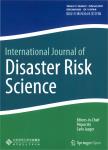Revisiting Emergency Food Reserve Policy and Practiceunder Disaster and Extreme Climate Events
Revisiting Emergency Food Reserve Policy and Practiceunder Disaster and Extreme Climate Events作者机构:Emergency and Disaster Management Studies Charles Darwin University Natural Sciences and Science Education National Institute of Education Centre for Non-Traditional Security Studies S. Rajaratnam School of International Studies (RSIS) Nanyang Technological University
出 版 物:《International Journal of Disaster Risk Science》 (国际灾害风险科学学报(英文版))
年 卷 期:2019年第10卷第1期
页 面:1-13页
核心收录:
学科分类:02[经济学] 0709[理学-地质学] 08[工学] 0303[法学-社会学] 0832[工学-食品科学与工程(可授工学、农学学位)] 0202[经济学-应用经济学] 083002[工学-环境工程] 0830[工学-环境科学与工程(可授工学、理学、农学学位)] 1201[管理学-管理科学与工程(可授管理学、工学学位)] 0708[理学-地球物理学] 0705[理学-地理学] 0837[工学-安全科学与工程] 0706[理学-大气科学] 0813[工学-建筑学] 0704[理学-天文学] 0833[工学-城乡规划学]
主 题:Climate change adaptation Disaster preparedness Emergency food reserves Food security Food stockpiling Southeast Asia
摘 要:All food systems will continue to be affected by disasters and extreme climate events. Triggered by recent food crises around the world and climate change concerns,some governments have been trying to develop more robust and resilient food systems. One of the oldest options for many governments is to stockpile emergency food reserves for the purpose of food security and disaster preparedness. In the aftermath of the world food price crises in2007–2008 and 2011, some governments in Asia have been maintaining emergency food reserves to ensure greater supply and price stability. Disasters and extreme climate events help governments to justify emergency food reserves. This research examined emergency food reserve policies in Indonesia, the Philippines, and Malaysia.Emergency food reserves emerged as a practice where the shared objectives of development, disaster risk reduction,and climate change adaptation have been demonstrated by governments. The findings suggest that most governments maintain the strong view that adequate emergency food reserves can buffer national food price shocks and shocks from disasters and climate change, and soften disruptions in trade due to export bans during times of disasters and climate emergencies.Under global climate change scenarios, food security is at risk and volatile(Porter et al. 2014). The expected increase in climate extremes has generated anticipatory actions from governments, including a new push for EFR policy adoption. Triggered by recent disasters and climate change concerns, some governments have been trying to develop more robust and resilient food systems(Fan and Brzeska 2014; Porter et al. 2014). For many countries in Asia, this means the renewed adoption of EFR. Unfortunately, we argue that this is not well understood in climate change adaptation studies as well as contemporary disaster studies.The Association of Southeast Asian Nations(ASEAN)first initiated a Food Security Reserve Agreement in 1979,with the purpose of meeting emergency requirements(ASEAN 1979). Policymakers have been aware of the susceptibility of the region to natural hazards and the possibility of food shortages. But it took 30 years, until soon after the world food crisis in 2007–2008(Hadley and Fan 2010), for the association plus three additional East Asian nations(China, Japan, South Korea) to establish the ASEAN Plus Three Emergency Rice Reserve(APTERR)in 2009, as a mechanism to address potential food shortages in the region in the light of climate and market uncertainties. The final formal agreement was signed in October 2011 in Jakarta(APTERR 2017).The Association of Southeast Asian Nations also established the ASEAN Food Security Information System(AFSIS) that functions as a central information repository for five commodities—rice, maize, soybeans, sugar, and cassava. AFSIS not only monitors and analyzes production,import, export, inventory stock, price, food security ratio,and self-sufficiency ratio for these commodities but also provides data on losses from both floods and droughts in every member state(Lassa et al. 2016). In theory, AFSIS serves as an early warning mechanism for ASEAN to trigger the activation of APTERR s response mechanism(Saengbangka 2014, personal interview; AFSIS 2017).This article argues that EFR can function as a means of disaster risk reduction, including climate change adaptation, and aims to understand why governments in Asia are readopting emergency food reserves as national policies,with a focus on Indonesia, the Philippines, and Malaysia.We also explore how disasters and climate change strengthen or weaken government narratives in support of emergency food reserves.



